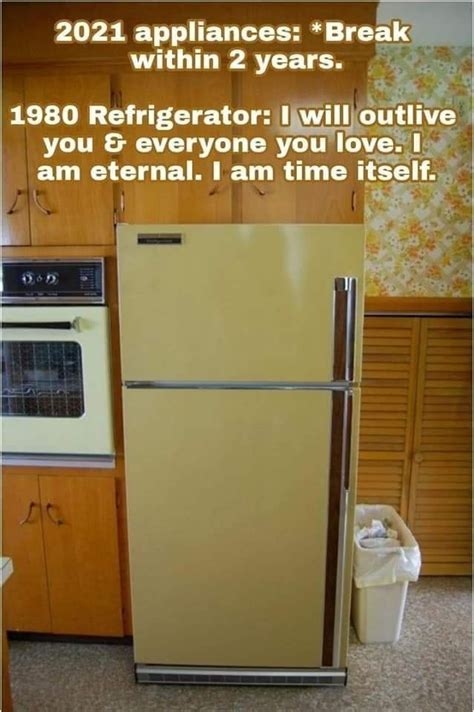It’s a “best before” date not an expiration date, it might still be good!
Probably still as good as it ever was… Lol
Same as it ever was
Take me to the freezer.
Put me in lasagna.
This is not my freezer burned meal!
Marinara flowing underground
Same as it ever was
Maybe they meant it was disgusting. Like they bought a couple, ate one, and decided not to eat the other, and didn’t get around to tossing it.
It’s probably still perfectly safe to eat. It likely just tastes like hot garbage. Frozen food doesn’t technically expire, it just slowly gets more and more freezer burnt that degrades the quality and taste. It remains perfectly safe to eat indefinitely, however.
This assumes there was no significant power outage for 27 years, which I would not bet on
How high did the item score? https://xkcd.com/2178/
From a reverse image search, looks like this was originally posted on Twitter by Orla Walsh, a dietician. Her education experience on her LinkedIn puts her at about 36 years old at the time the image was posted (July 2023). Since this is her mom’s fridge though, we estimate her age at 36+25=61. So, total score is 42.62.
What formula are you using? And where did 25 come from? 2023-1997 = 26 and (26 / 36) x 100 = 72.2
Edit: nevermind, I see you were estimating the mom’s age. My bad, all is well.
I kind of want to see a charter plot of that scoring function projected onto a 3-axis manifold with a colored heat map. How would I minMax my anticipated score given my current age or projected lifespan?
Best before 2097? What’s the problem there?
Y2K
No, no, it can only be 1997, logically.
The Y2038 problem.
There are no years before 2000.
How many power outages has that Lasagna seen?
Inside it’s just a box of snow with cheese.

Isn’t this just survivor bias?
The unreliable fridges from 1980 have all failed already.
In Engineering you have two different kinds of failures:
The first is to do with manufacturing flaws and happens in the first couple of months of use, hence how Warranties work - bad part of bad assembly so it breaks on first use or soon after.
The second kind is the device dying from decay due to use, from old age if you will.
Survivor bias, IMHO, only applies for those devices that last beyond the stage were the first kind of failure can happen as it’s kinda random (you can reduce the proportion of devices that fail, but for any one device it’s random if it will be one that fails or not)
So a 3 year old fridge dying is not from manufacturing defects but it’s dying from faster ageing, which is a flaw in the design or a choice of cheaper, lower quality components.
From what I’ve seen that’s exactly what’s been happenning: less robust designs and cheaper components with shorter lifespans, all to save on raw material costs.
Lower manufacturing quality tends to cause the first kind of failures, not the failures well past the first few months.
PS: Note that dying from the second kind of failure still has a random probability for any one device, though whilst the probability from dying from manufacturing flaws is very time dependent (starting very high and then tailing off to pretty much zero within some months), the probability of dying from age is a lot less time dependent and if that much increases slightly with increasing age (whilst the other kind decreases steeply with age, specifically decreases steeply with use). I’m mentioning this for completness, as the point still stands - if there is a high proportion of devices of a given type dying at year 3, then that design has a much higher rate of failure due to aging than devices for which a much smaller proportion dies at year 3, hence the design is not robust and/or lower quality components are being used.
With some exceptions, like lamps or tvs, older devices lasted much more. You can inspect the older devices you find around you and check for yourself. In general, they were much more robust and used better components and were designed to last. This was due to a lot of things that were different. I will try to list some:
- in some industry areas, growth in the market was mostly due to population increase, people who never got access to some things being able to buy them, and expansion to development countries, so it was better for the companies that the devices lasted long, because they wouldn’t be able to supply a demand of replacement + new users. In other words, there was no incentive for products with small life.
- devices were generally simpler, with fewer components, therefore, with fewer points of failure. The components used were often more “brute”, instead of the delicate electronic components we have.
- a lot of the modern obsolescence comes from software and from i/o communication incompatibilities, things that weren’t even present in most devices
- market demand forces prices down, and this has led to many things, including worse quality stuff
- the life cycle of everything has diminished, as the consumerism became stronger, and people are buying new things much faster, leading to users not even caring for things to last long, because they will buy a new one soon anyway.
These are the things that came to my mind. However, it’s important to remember that there are products being made out there with the same robustness level of old appliances. Look into industrial devices, for example. They’re build to last for decades and endure much more than common devices, but the prices aren’t inviting to the average user.
Could be, but I think it’s been well established that things just used to be built better before globalism moved American manufacturing jobs to SE Asia.
I want my whole kitchen and laundry room using 1980s tech
What do you mean, it says new right on the box. Can’t be that old
NOS food
March 97 of what year?
L5264. You know, just a while after the Mayonnaise Wars of K3737.
The rising red river of the 52nd Ketchup alliance was a dreadful day indeed. Only the infidels call it the Mayo war.
Some say the rivers ran red from all the ketchup spilled in the greatest battle of the war.
2097, obviously, cause 1817 there were no plastics* or refrigerators** or cameras cheap enough to take pictures of trivial shit*** and 1997 would be to obvious. Nah, its definitely not 1997
wat?
Let’s get this out onto a tray.
Nice
No hiss
Nonzero chance that abiogenesis occurred in there
check out this custom flavour profile!
How big is that freezer the she forgot a lasagna in there for this long?
Tomb style freezer probably, the bottom is basically inaccessible so shit gets forgotten…
My mom didn’t defrost the freezer for ages. It’s finally dead, but it took 2 hours just for the doors to unfreeze from the rest so I could open them.
See for yourself:

So perhaps a similar issue.This is a profile photo of anxiety.
Ooh, raspberry snowcone
It’s beautiful
What’s the freezer brand? That’s a buy it for life candidate if it worked for a long time with no maintenance.
It’s some fridge+freezer combo from Electrolux.
It still technically works, it’s just that the door doesn’t close properly, making it kinda useless. It was only shut off due to high temp alarm, which I am surprised took so long to turn on as there was some gap in the doors all the time.
I’d honestly be impressed by a freezer that’s been running since '97.
I have a freezer from 1953, works fine. It’s appliances made after @2000 that shit the bed in 5 years or less. No, it’s not survivorship bias, there’s a certain time period you don’t see anything survived from.
No, it’s not survivorship bias
Yes it is. The probability is much more significant that there are appliances from 2000s still working fine while your 1950s piece is one of the last few left. Just because your reality has a different view doesn’t mean it’s the same on a global scale.
No, it’s not. You should see a bunch of appliances from that era like you do older eras, but they’re just gone. My 53 fridge i bought last year, i was so happy when it turned on again. Moving them at that age is risky as hell. but I have ten fridges and 6 freezers i use to run my small town restaurant. I’ve paid close attention to the used market, I’m not just blowing random horseshit. Commercial grade is a different story. but wasn;t what I was talking about.
Nokia 3310 would like to have a chat with you
appliances
That’s before they started building them to fail. Why? Because a freezer that’s been running since '97 is at least two unsold new freezers.
There’s also a lot of other stuff that changed over time. New appliances may be more efficient, run on different (more environmentally friendly) coolant, have lead-free solder circuits, etc.
The thing is, a lot of that old stuff which was found to have health or environment issues also lasted longer. Leaded solder didn’t get burrs, for example. The components may also have been easier to repair.
But there’s also survivor bias. For every old freezer that sat in grandma’s basement for 2-3 decades many more ended up in a scrap heap.
Even this picture is a decade old by now.
Wow lol
Do you have proof that this person is the original poster? I have seen this image so many times…
No, but can you find an earlier time it was posted?
Bro dont break my meme heart like this
Does that brand even exist anymore?
One would hope not
So it’s a collectible!
A colledible!
Maybe it ages like wine.
Uncorked?
It does say new on the package


















